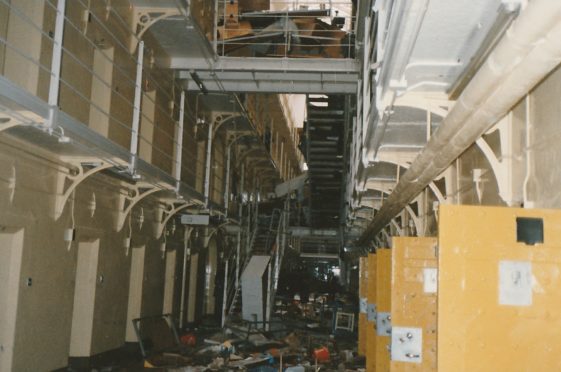Incredible never-before-seen images of the riots that tore through one of Scotland’s toughest prisons in 1987 are to go on display to the public.
Peterhead Prison was the scene of mass destruction, hostage taking and intervention by the SAS as the chaos captivated the UK.
Prison officer Jackie Stuart – who can often be found at the now Peterhead Prison Museum recounting his tale – was held on the roof by prisoners for days.
Now, the chance find in packets and suitcases of stunning pictures showing the aftermath of riots will be put to good use.
Many of the photographs are to be used as part of a new exhibition marking the anniversary of the riots, which will go on display next week.
Operations manager of Peterhead Prison Museum, Alexander Geddes, said “It’s scary how quickly the anniversary of the 1987 prison riot comes round every year.”
The popular tourist attraction was shut for months due to the Covid-19 pandemic and only re-opened its doors to visitors on July 15.
Staff at the museum normally have time to plan how they’ll mark the next anniversary “but this was lost” due to the museum’s closure.
By chance staff at the museum uncovered photos of the prison riots several weeks ago which “clinched” how this latest anniversary will be commemorated.
Suitcases full of memorabilia, ranging from uniforms to documents, have been salvaged from years gone by over time and they were found within that collection.
Mr Geddes said: “It takes time as you can imagine to go through all these documents and by pure chance we opened this suitcase and here were all these images taken shortly after the siege ended.
“It was almost like a gift when we were thinking of the next anniversary and where we were going to go with it, and here was a folder full of images.”
The photos that will go on display will show the full extent of the riots’ aftermath.
Mr Geddes added: “You’ll see everything from the toilets that have been smashed up, to the walls set on fire and you will also the damage caused from the floors above.
“There are photos of furniture that was smashed up and thrown down staircases.
“The galleries were totally full of furniture to stop the staff getting up the stairs to try and get Jackie Stuart out.”
Mr Geddes is certain this will have “quite a strong impact” on visitors.
He said: “The damage really needs to be seen. It’s difficult to describe in words exactly what it looked like.
“It will have an impact on visitors standing in the space but seeing the images of how it looked just after the riot.”
The “unique part” about the 1987 riot was the intervention from the SAS, but it wasn’t the only major disturbance the prison encountered.
The display will also feature images from the aftermath of an earlier riot, in 1986, in which prison officer John Crossan was held on the roof by several inmates.
Mr Geddes said: “John Crossan was held captive on the roof of A-hall which was the opposite side from where Jackie was held.
“In a similar manner to the 1987 riot, it started over something minor that soon escalated.
“There was an uneasy feeling in the prison before it had started.
“These images will give visitors an understanding of the different riots that took place.”
Peterhead Prison Museum will have the images on display for visitors from Tuesday.
History of the 1987 riot
Over 30 years ago, Peterhead Prison was the focus of worldwide media attention after a notorious riot broke out.
On September 28, 1987, a disturbance in the prison’s D-wing escalated until prisoners took over the building and held prison officer Jackie Stuart hostage on the roof.
The criminals who had taken the 57-year-old prison officer were serving life sentences for an array of violent crimes.
Prison authorities later confirmed a “minor incident” had occurred on the morning of the riot but soon spiralled out of control.
Mr Stuart intervened when an inmate attacked a fellow prison officer with a knife but he was himself overpowered by rioters.
He was held hostage for five days, regularly paraded in front of the authorities and TV cameras by his captors, 75 feet up on the rooftop.
Mr Stuart was routinely beaten and was used by the prisoners as a bargaining chip in their ongoing negotiations.
His captors claimed to be protesting the distance their families had to travel for visits, as well as the conditions within the prison.
It was hoped the rioters would surrender, but on October 3, the then home secretary, Douglas Hurd dispatched the SAS to bring matters to an end.
While prison riots weren’t uncommon across Scotland at the time, this was the only incident where the SAS was used to end a siege.
Peterhead Prison was built in 1888 and housed some of Scotland’s hardest and most violent men for 125 years. It closed its doors in 2013 and is now a museum.
